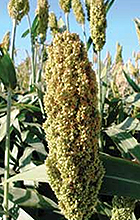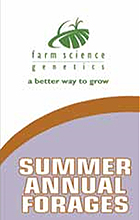
- Developed specifically for game birds
- Resistant to sparrows and blackbirds during milk stage
- Grain is resistant to weather deterioration
Wildlife Grain Sorghum was specifically developed as a fall and winter food source for upland game birds (quail, turkey, pheasant and prairie chicken) and migratory birds (ducks, geese and doves). Unlike many conventional grain sorghum hybrids, Wildlife Grain Sorghum imparts a bitter grain taste to predatory birds (sparrows, blackbirds, starlings, etc.) during the milk and dough stages of development. The bitter taste disappears when the seed reaches maturity.
Wildlife Grain Sorghum is a heavy seed producing, early maturing (50-55 days to mid-bloom) variety which has early planting cold tolerance and excellent tillering for greater variation of grain maturity. Plant height is 35 to 40 inches for easy hunting. The white seed color is only in the pericarp layer of the seed and acts as a mold and rotting repellant for the grain during exposure to winter weather conditions. In addition to providing a non-weathering and non-rotting winter food source, the foliage provides an excellent source of beneficial cover for birds.
Wildlife Grain Sorghum is not meant for commercial grain production due to high tannin content.

- BMR gene technology reduces plant lignin content versus conventional hybrid pearl millets, which results in a highly digestible forage with improved nutritional quality
- Extensive tillering capacity
- High yield potential
- Dwarfing gene increases the leaf to stem ratio, improves standability and allows heavier grazing pressure
- Adapted to a wide soil pH range
- No Prussic Acid concerns
FSG 315 is a new concept in hybrid pearl millets with BMR and Dwarfing gene technology. The BMR gene reduces plant lignin versus conventional pearl millets resulting in a highly digestible forage with improved nutritional quality for superior animal performance. The Dwarfing gene increases the leaf to stem ratio for higher forage quality, improves standability in the field and allows heavier grazing pressure with its extensive tillering. With high yield and quality potential, an excellent disease resistance package, drought stress tolerance and rapid growth, FSG 315 is ideal for the grower who wants the flexibility of grazing, hay or silage.

- Bushy type hybrid with high yield potential
- Widely adapted to many diverse geographic regions
- No Prussic Acid concerns
FSG 300 is a bushy type hybrid pearl millet with high yield potential which is achieved very quickly needing only 63 days to reach the boot stage. FSG 300 has a high level of tolerance to many pathogens and high humidity, but cannot tolerate standing surface water. FSG 300 can be grown on as little as 16 inches of water, however, greater tonnage will be produced with greater water availability.
FSG 300’s bushy type plant stature means that the forage produced is virtually all leaves. This greater leaf mass gives FSG 300 high crude protein concentrations and high TDN values.

- High yield potential
- Up to 20% increase in digestibility
- Multiple uses: hay, grazing, greenchop and silage
- Excellent for 1-3 cut forage systems
FSG 215 BMR6 produces some of the highest dry matter yields of any BMR and non-BMR hybrid sorghum-sudangrass commercially available. With excellent nutritional quality and early vigor, FSG 215 BMR6 is highly digestible with increased efficiency and improved animal utilization due to reduced lignin, the limiting factor in forage digestibility. This hybrid has excellent drought tolerance and is quick growing, producing the maximum tonnage in the shortest amount of time. Fine, sweet stems makes FSG 215 BMR6 an excellent choice for grazing, hay, greenchop and silage.

- Up to 20% increase in digestibility
- Significant increase in palatability
- Dry stalk gene improves harvest timing
- Multiple uses: hay, grazing, greenchop and silage
FSG 214 BMR6 is an exceptional quality hybrid sorghum-sudangrass with excellent early vigor and high yield potential. The dry stalk gene improves dry-down and normally shows 8-10% lower moisture in the boot stage. FSG 214 BMR6 tillers profusely, producing fine sweet stems for high palatability.
This hybrid shows an increase of up to 20% in digestibility due to the reduction in lignin with the BMR6 gene, providing increased daily gains in milk and beef production. When compared to BMR sudangrass hybrids, FSG 214 BMR6 is more economical to plant, produces more dry matter yield, has similar stem size and higher overall quality.

- Small seeded and thin stemmed type
- Dark green color with Green Top trait
- Anthracnose and Downy Mildew resistant
Greengrazer V is a small-seeded three way cross with thin stems that are highly palatable. Regrowth after cutting is very fast. Greengrazer V is a dark green color and also possesses the Green Top trait, which allows for further extension of the plant. Planting Greengrazer V, at higher populations per acre, will result in a finer stemmed forage. Finer stems will allow the forage to dry faster for higher quality hay than is possible with thick stemmed types. For grazing, wait until plants are 18”-36” tall. Remove cattle when plant height has been grazed down to 8”.

- Significantly lower stem lignin concentration
- Improved digestibility & palatability equals milk production of rations with corn
- Requires 1/3 less water than corn for same production
- Male sterile hybrid
- Dry stalk gene improves harvest timing
- 75 day harvest maturity
FSG 118 BMR6 is a brown midrib, male sterile hybrid forage sorghum that reaches harvest maturity approximately 75 days from planting. Because the lignin content of the stalk has been dramatically reduced, digestibility improves by 35% over conventional forage sorghums. FSG 118 BMR6 forage sorghum, with this improvement in digestibility and palatability, can equal the milk production of rations with corn. Plant at the recommended rates for your area and harvest timely for optimum yield and quality. The water requirement for FSG 118 BMR6 is 1/3 less than would be required to produce an equivalent amount of corn. Because FSG 118 BMR6 is a male sterile hybrid, volunteer growth is not an issue provided there is adequate isolation from pollen fertile sorghums.

- Dwarfing gene increases leaf to stem ratio and provides superior standability
- Significantly lower stem lignin concentration
- Improved digestibility & palatability equals milk production of rations with corn
- Requires 1/3 less water than corn for same production
- Grain producing hybrid
- 95 day maturity for northern states and 110 day maturity for transistion states
FSG 115 is a brachytic dwarf, brown midrib, grain producing hybrid forage sorghum. Because the lignin content of the stalk has been dramatically reduced, IVDMD is 40% greater than conventional forage sorghums. FSG 115 with this improvement in digestibility and palatability, can equal the milk production of rations with corn with a water requirement 1/3 less than would be required to produce an equivalent amount of corn. Because FSG 115 is a grain producing hybrid, energy will increase as carbohydrates form in the grain head.

- Significantly lower stem lignin concentration
- Improved digestibility & palatability equals milk production of rations with corn
- Requires 1/3 less water than corn for same production
- Male sterile hybrid
- Dry stalk gene improves harvest timing
- 85 day maturity
FSG 114 BMR6 is a brown midrib, male sterile hybrid forage sorghum. Because the lignin content of the stalk has been dramatically reduced, digestibility improves by 35% over conventional forage sorghums. FSG 114 BMR6 forage sorghum, with this improvement in digestibility and palatability, can equal the milk production of rations with corn. Plant at the recommended rates for your area and harvest timely for optimum yield and quality. The water requirement for FSG 114 BMR6 is 1/3 less than would be required to produce an equivalent amount of corn. Because FSG 114 BMR6 is a male sterile hybrid, volunteer growth is not an issue provided there is adequate isolation from pollen fertile sorghums.


